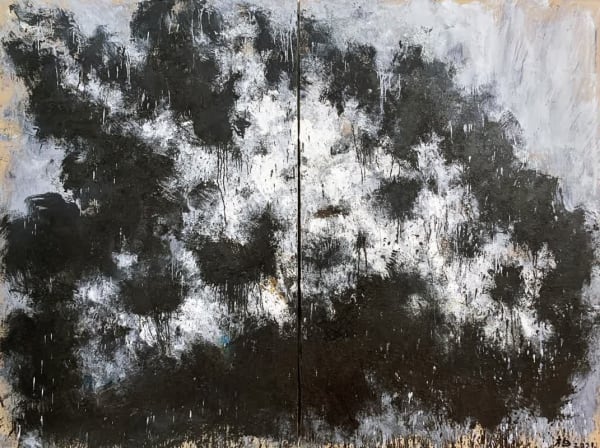Leo Gallery
Art Basel Hong Kong 2024
UNRESTRAINT
Works by Li Di and Zhang Fangbai
Booth 3C 44
26 - 30 March 2024
Hong Kong Convention and Exhibition Centre
Leo Gallery proudly presents “Unrestraint”, a joint exhibition by Li Di (b 1963, Inner Mongolia, China) and Zhang Fangbai (b 1965, Hunan, China) at Art Basel Hong Kong 2024.
"Unrestraint" is known as "Shu Ye" in Chinese pinyin. It is one of the twenty-four categories of poetry in the late Tang Dynasty. The artistic style of "Shu Ye" is characterised by simplicity and naturalness. This style emphasises a natural and straightforward approach, without excessive literary embellishments, in both the spiritual content of the work and the language used. Li Di and Zhang Fangbai, both born in the 1960s and graduates of the Oil Painting Department of the Central Academy of Fine Arts in Beijing, possess a strong visual language and skilled painting techniques. Their works embody a freehand expression that blends intentional and unintentional brushwork. Their works also share many similarities with German Neo-Expressionism, reflecting a distinctive Chinese aesthetic.
As an artist who has witnessed and adapted to the development and changes in contemporary Chinese art over the past four decades, Li Di no longer sees Neo-Expressionism as his own artistic path. Instead, he attempts to dissolve the meaning of artistic spirit within his everyday visual experiences. He seeks to reconstruct the expression of lyrical emotions by returning to the language of painting itself. As early as the 1980s, Li Di drew inspiration from the philosophies and literature that emphasized individual independence. He also absorbed the style of German Neo-Expressionism, which made him question the academic art that he had been adhering to. He realised that in the new era, art needs a purification of ontological language and a deeper integration with social connotations. This purification is not simply a state of accepting or rebelling against contradictions, but also a reflection upon oneself. During Li’s stay in Germany from 1990 to 2010, his creation underwent a transformation as he explored new forms of expression. He broke away from the constraints of academic painting and continued to develop his spontaneous and expressive style. Since returning to China in 2010, Li Di has entered a new phase of artistic exploration, characterised by a freer and simpler language. Inspired by the contingency of Chinese Zen painting, he dissociates figures from narrative and replaces the narrative with abstraction. In “Unrestraint”, it features Li’s "Chung Hwa HB", "Jian Bai", "Ecke" and "Criss-Cross" series. From pencil on wooden panels to charcoal on paper and acrylic on canvas, which showcase the evolution of his painting language after returning to China.
Zhang Fangbai's artistic journey is deeply rooted in traditional Chinese painting, and he has developed a unique visual language. Zhang proposed experimenting with Western art in his essay 'My Views on Establishing Chinese Local Art' when applying for the undergraduate program at the Central Academy of Fine Arts in 1987, which foreshadowed the path that he would take in his future artistic career. During his teaching career at Tianjin Academy of Fine Arts, he clearly stated his direction of exploring the path of Chinese visual art, and the “Eagle” series that he created during this period sought to connect contemporary art with Chinese aesthetics. Zhang absorbed the influences of European Neo-Painting and German Expressionism, and attempted to incorporate elements of traditional Chinese aesthetic imagery through the absorption and exploration of Chinese calligraphy and ink painting. He sought to achieve a balance between the pursuit of traditional aesthetics within the forms of expressionism, focusing on the harmony between "qi yun" (vitality) and "zhang li" (tension). His technique, known as the "accumulated ink method," utilises a grayscale palette with thick, textured brushstrokes, disrupting the visual order and existing within the intersection of the tangible and intangible, the real and the abstract. In his artistic imagery and creative process, one can perceive his intentions to transform and reconstruct the artistic pursuits of Ba Da Shan Ren (Eight Eccentrics of Yangzhou), aiming to explore new forms of Chinese expression. Zhang's works, including the “Eagle”, “Frozen”, “Root” and “White Stone” series, will be featured in “Unrestraint”. By fusing his personal ideological changes, Zhang has created unique configurations that showcase his individuality and artistic expression.
With nearly forty years of artistic careers, Li Di and Zhang Fangbai have each explored the boundaries of painting language in an introspective way. “Unrestraint” showcases their exploration and practice of contemporary Chinese expressionist painting, providing a unique opportunity for viewers to explore the artists’ journeys in merging Eastern and Western expressionism. The exhibition also facilitates a dialogue between the two artists, highlighting the ways their works intersect and their artistic vision.




